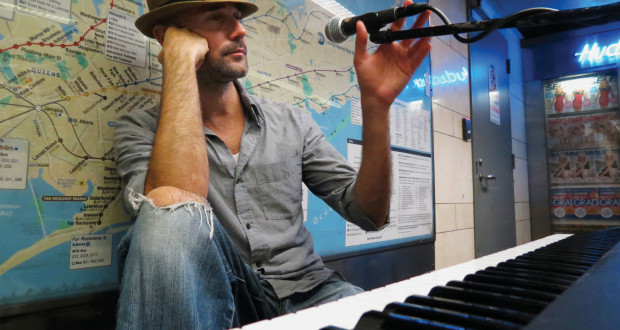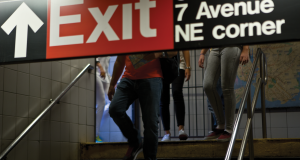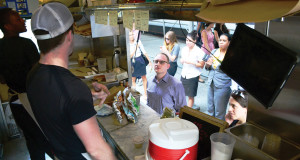It’s 8:30 a.m. on a Friday morning at Penn Station. Commuters hurry along from one platform to another, clutching their bags, luggage and umbrellas close. New York weather on this day has been gray skies and cold fronts.
Gabriel Aldort, much more known as Galdort Gumbo, is a musician and singer who plays every week at the subway to an audience that rarely stops or applauds.
It’s not a typical show. Aldort is part of the Music Under New York (MUNY) program administered by the Metropolitan Transportation Authority’s Arts for Transit and Urban Design initiative. MUNY allows musicians such as Aldort to perform in public spaces frequented by commuters.
His style is grungy, with ripped jeans, a cotton shirt with rolled-up sleeves, and a straw hat. The 42-year-old from Northport, Long Island, lugs a square pushcart containing an electric piano zipped up in a black case, a folded chair, an amplifier, a microphone and a speaker. Pushing his 50-pound cart from his home in Washington Heights to Penn Station, Aldort says it takes him a half-hour to reach his spot, navigating stairs, doors and gates with ease along the way.
In just 10 minutes, the makeshift stage is ready. He’s in front of a Long Island Rail Road map, which captures the attention of tourists, inching close to the wall to find their destination along the colorful maze of train routes. Aldort has no manager or security to tell these commuters to stay away.
His piano bag lies on the floor in front and doubles as a collection bag for generous tippers who like his music. A placard rests on the bag and indicates the musical genre this artist loves: New Orleans blues. He’s even laid out copies of his first album for anyone who wants to take his music home. The music stand next to his piano doesn’t hold sheets of music but rather CDs titled “Thanks for Today,” a song he wrote as a Thanksgiving prayer for his mother.
“Thanksgiving is our favorite holiday of the year,” Aldort says, smiling after playing his title track, a personal favorite of his.
Aldort pauses before he starts playing, his eyes momentarily shut, as if he is saying a prayer, and then starts to glide his fingers across the black and white keys, playing cover songs from the ’80s and ’90s.
“I was sick, having problems with my relationship. …You have five minutes to play, and it’s bang bang bang…”
– Gabriel Aldort
Founded 26 years ago, Music Under New York gave the subway a facelift, with the goal of making commuting a pleasure, not a pain. It included cleaning up the graffiti-covered walls and adding music to the mundane environment.
Today, musicians, artists and poets perform regularly, making MUNY a sort of prestigious membership for New York City performers. Auditions are held every year, and about 70 musicians are selected to play anywhere underground, according to Amy Hausmann, deputy director for MTA Arts for Transit and Urban Design.
“They are selected on three different parameters: musicianship, variety of music and the appropriateness to the transit environment,” Hausmann says.
Subway performers have been given their musical break by top record labels after being spotted underground in the humid confines, performing near rusty old iron beams caked with years of train soot, or inside trains and between stops, finding a passage or a hallway to stand or sit on a box and do what they love doing. Being a subway performer isn’t always about big breaks, but small steps of success and personal achievements for the performers.
Aldort plays four days a week at various spots in the underground network, which includes the Staten Island Ferry stop on Wednesdays. Getting to this spot in his life started with a chance meeting with a violinist at a wedding. One of the members in the group nudged Aldort to try out, and, after much procrastination, he entered the competition three years ago.
“I sent in my audition tape on the last day you could send it in,” Aldort says.
He made it to the final audition, but circumstances didn’t bring out his best performance, or so he thought.
“I was sick, having problems with my relationship. …You have five minutes to play, and it’s bang bang bang. … You have a couple minutes to set up and you’re on,” he says as he recollects the moment he played in front of the judges and the media.
Aldort didn’t realize he had won over the judges, a sponsorship and a permit to play at choice spots in the subway and a lifelong set of shows.
“People can sniff out insincerity,” he says. “They really can, and I see it reflected in my tips.”
Reminiscing about his audition, he says a big surprise came when Freddy Orange, a schedule coordinator for Hospitals Audience Inc., an organization that places musicians in various care facilities in New York’s five boroughs, asked him if he’d like to play at one of the facilities.
“It’s the most fulfilling experience of my life,” says Aldort, who juggles multiple jobs, including the weekly care-facility shows.
His first show as a MUNY performer was at the same spot he’s playing at on this day.
Three years ago, as he first set up and started to play, he found alongside his tips, a present: a silk scarf. He kept that as a good-luck charm, tying it to his microphone stand but over time replaced it with the Mardi Gras beads that add a bit of color to the otherwise monochrome setup.
Aldort’s slightly raspy voice gives every song a new twist that has captivated his in-transit audience. Being a subway performer has been transformational and therapeutic, he says. It has helped him shed performance anxiety. He’s also learned to stay humble, a quality that matches his songs.
“People can sniff out insincerity,” he says. “They really can, and I see it reflected in my tips.”
Three years ago, Aldort thought his emotions confounded his professional performance. However, his problems helped him get his break as a performer and artist.
“It’s just a testament to our perception of things can be very different because I thought I bombed,” he says. “But I didn’t bomb.”
Galdort Gumbo will be performing Friday from 8 a.m. to noon at the Lexington and 59th Street subway station on Uptown 6 platform.
 VOICES Publishing from the AAJA National Convention
VOICES Publishing from the AAJA National Convention







